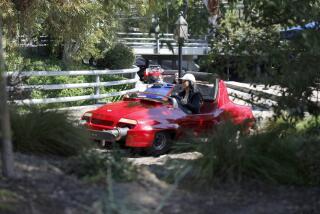Auto Didact
Pencils, clay knives and computer-imaging applications shape J Mays creations; something less tactile animates them. Perhaps no other automotive designer active today seeks out our heartstrings as doggedly or successfully as the 53-year-old Oklahoma native. Mays, the group vice president of design at Ford Motor Company, has authored some of the past two decades most compelling forms for multiple brands, such as Volkswagens New Beetle, Fords latest Mustang and Audis proto TT, the Avus Quattro concept.
Most designers would kill to leave such a legacy of innovation. Mays, however, sees little value in isolated successes. Ford is currently banking on its design chiefs radical new aesthetic direction, called Kinetic Designa relentlessly futuristic style set to revamp the Blue Ovals domestic line. The move might seem a strange fit given Mays portfolio. This is the man, after all, whose uncanny ability to reconceive and repackage vintage, not modern, design has spawned his greatest triumphs.
Right down to the bud vase by the steering wheel, Volkswagens New Beetle, arguably the most sensational automotive statement of the 1990s, was Mays doing. In 1994, he oversaw the manufacturers Simi Valley design center, where he created Concept One, which evolved into the 1999 Beetle. Driving the car, reformed flower children could revisit the We Decades ripe promises in comfort and safetywith fewer pullovers and pat-downs by the fuzz.
Previously, Mays had created the Audi Avus Quattro, a wondrous concept car that referenced Fritz Langs 1927 film, Metropolis and the German Bauhaus design school, and which begat Audis TT sports coupe.
Arriving at Ford in 1997, Mays kept the hits coming. He ended the Thunderbird coupes quarter-century malaise with a 2002 design borne of malt-shop-and-drive-in dreams. His awesome 2005 Ford GT, a limited-edition $140,000 supercar, hewed so closely to its inspirationthe dominant GT40 racecar of the 1960sas to be almost indistinguishable.
Mays called his Boomerbaiting style retrofuturism. It would earn him simultaneous retrospectives at L.A.s Museum of Contemporary Art and Harvards Graduate School of Design. It also likely experienced its high-water mark this year with the Mustang Bullitt, an homage to the 1968 movie and the Mustang in which Steve McQueen hurtled over San Franciscos streets. The Bullitt was probably the simplest thing Ive done at Ford, yet for the people who bought the 6,500 examples in just over three and a half hours, it had tremendous cultural meaning, Mays says. It struck an enormous chord. The reference was as important as the car itself.
Demographic shifts, however, suggest new chords to strike, and todays automakers are dedicating massive resources to winning over the next great purchasing bloc: Generation Y, or millennials. While its doubtful Mays nostalgia-charged style has drawn its last breath, retrofuturisms shelf life is clearly dictated by the driving habits of an aging target market.
Mays is not sweating. If anything, the gauntlet thrown down by millions of young Americans fills him with urgency. This is the first generation with essentially the same psychographics, regardless of where theyre at geographically, he says. If a millennials sitting in Milan, he or she has a very similar eye for design as one sitting in Los Angeles or Atlanta, because theyre drawing on the same design sensibilities through the Internet.
Consequently, it takes a scru-pulous, informed eye to create cars for this new generation of consumers. Thanks to Mays direction, Fords Kinetic Designinfluenced products possess sharp, origami-like creases in the bodywork, as well as warm, round forms in the fenders and rooflines. The overall feel is upscale, not robotic or plush-toy cuddly, and suggests forward motion from any angle.
To gauge Kinetic Designs early impact, picture a scene from last Januarys Detroit Auto Show: Scores of horsepower-enthralled car journalists crowded into the Ford pavilion at Cobo Arena, salivating in the presence of the 2010 Ford Fiesta, a four-cylinder, two-door hatchback. Southern Californians of a certain age might shudder at any mention of the Fiesta name, last seen attached to a vehicle likely dragging its muffler down Van Nuys Boulevard during the energy crisis of the 1970s.
The Fiestas newborn descendant, however, is lithe and spry, with a swept-back stance telegraphing pure movement. We decided about three or four years ago that Ford cars werent reflecting a dynamic driving experience in their visual design cues, Mays says. When somebody looks at your car, you want it to visually communicate the vehicles technical prowess and driving dynamics.
Fords domestic models have barely savored Kinetic Designs racy postmodern kiss, yet Mays was already convening his European design teams in Germany last month to ponder a post-Kinetic future. Granted, automotive-design languages these days are conceived, put through their concept-car paces and, with any luck, placed into production with astonishing speed. What comes after Kinetic? Thats the million-dollar question, he says. Actually, its closer to a billion.
More to the point: $8.7 billion. With truck and SUV sales plummeting, Ford posted its largest-ever quarterly loss last summer. This stoked concern in Southern California that Ford might shutter its Orange County advanced-design studio, where some of its most radical concepts are generated. More broadly, industry leaders fear for Southern Californias status as an incubator of bold design. Car designers have chased muses along Malibus stretch of Pacific Coast Highway, around the San Bernardino Mountains hairpin turns and down clandestine Burbank drag strips for decades.
Do these touchstones still resonate for young designers and buyers, particularly those in emerging global markets? Mays, a graduate of the transportation design program at Pasadenas prestigious Art Center, understands whats at stake. Designing [in California] is an integral part of the business at Ford, he says. And California is still an incredibly evocative place. We have no intention of leaving.
Meanwhile, the post-Kinetic forms crowding J Mays dreams might yet coalesce into another winning vision. He has succeeded in making the future appear retro and the present seem futuristic. It is a tricky business, he avers, but its one he relishes. Im still looking for the industrial designer who said the hardest thing in the world to design is a chair. That guy clearly never did an automobile.
Jonathan Schultz writes about car design and reviews products for magazines including I.D. and Intersection. He lives in Brooklyn.
More to Read
Sign up for our L.A. Times Plants newsletter
At the start of each month, get a roundup of upcoming plant-related activities and events in Southern California, along with links to tips and articles you may have missed.
You may occasionally receive promotional content from the Los Angeles Times.






